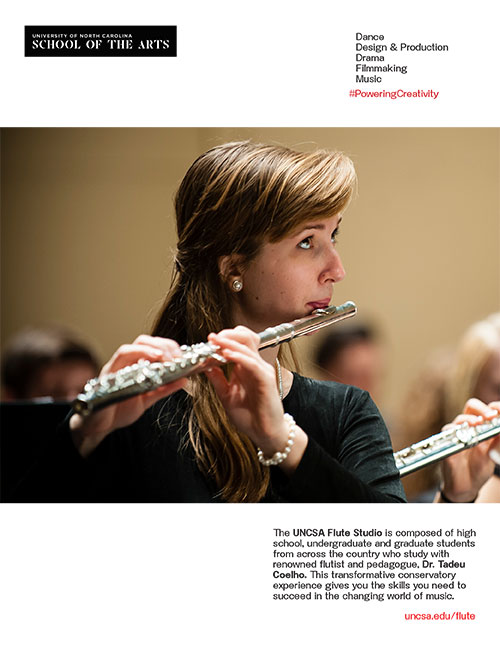One of the best things about playing piccolo in the Chicago Symphony is the privilege of sitting right next to a magnificent string section. Under our present music director the cellos and basses are my close neighbors and second violins are situated opposite the first violins in the so-called classical-style seating. Many guest conductors prefer having second violins next to first violins, so I have the double pleasure of hearing either violin or cello and bass sonorities
Years of observing and listening to my string colleagues have taught me a great deal about phrasing, articulation, and breathing. (Students will readily attest to my penchant for analogies between bow technique and air management.) Especially fascinating are the bowing choices – the up-bow and down-bow sequences that bring out the best phrasing and character of a passage. The concertmaster and other string section leaders decide the bowing patterns for each work, subject to occasional changes by the conductor, and these are penciled into individual parts by the library staff.
Because of this preoccupation with bowing, string players, in startling contrast to their more conservative wind and brass brethren, have no qualms about revising printed slurs. Sometimes this is to make the bow changes proceed in a more logical manner for better phrasing, to make the printed accents more effective, or to increase volume.
The latter is the most frequent case because at slow tempos long slurs in forte passages must be divided into shorter ones for faster bow speeds that produce more sound. The opening Un poco sostenuto of the Brahms First Symphony is a good example.
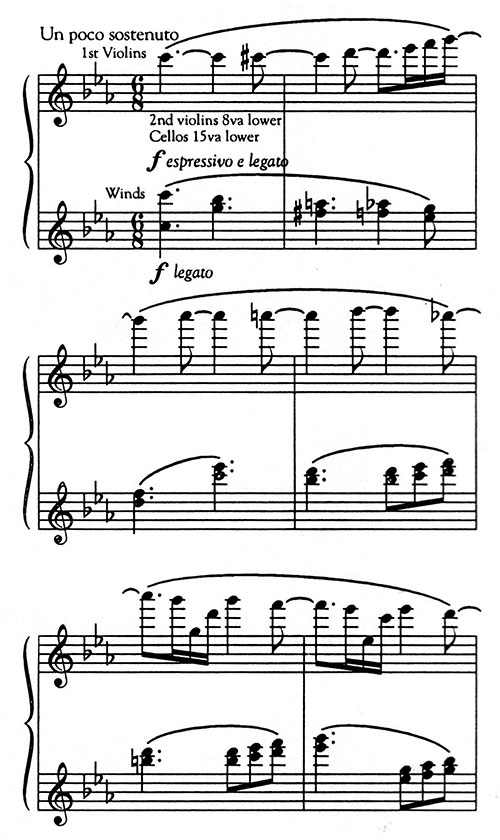
The violins and cellos have a continuous slur for the arching eight-bar theme, but Brahms did not mean this to be played in one bow. He wanted an intensely smooth musical line (his marking is forte expressive e legato) with seamless bow changes. Most orchestras average two bow changes per bar, but a few conductors will specify staggered bowing for a smoother sound, although it doesn’t look as good to the audience. Simultaneously the winds and violas have a long, legato countermelody, but for them Brahms indicates a new slur in each bar except the second. In performances where double winds are used, staggered breathing works perfectly.
In bars 19-20 the first violins double the descending first flute and bassoon line in octaves.
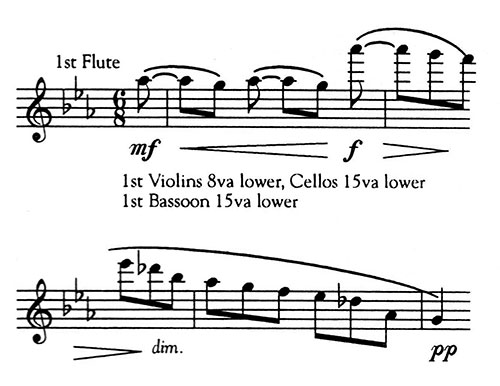
Interestingly, most flutists and bassoonists can easily play these two bars in one breath, but to sustain intensity the violins use at least two bow strokes. Though this may appear to be an unfortunate compromise, first-class string players are amazingly adept at hiding these bow changes.
One passage in the first movement Allegro of Brahms’s First has always puzzled me. In bars 53-55 and in many analogous places the flutes, oboes, clarinets, and violins all have the same articulation notated, but the violins (and later the violas, cellos, and basses) interpret this as a standard notation for a hooked bow, meaning that the eighth notes are distinctly separated from the previous long note. At the same time the winds interpret this as a pure slur to the eighth note but make the eighth note short. Daniel Barenboim and Gunther Schuller1 are to my knowledge the only conductors that ask the strings to slur this in the style of the winds.
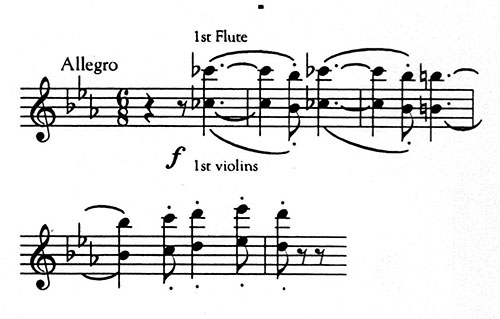
With other conductors the winds and strings merrily go their separate (or slurred) ways. I once asked Erich Leinsdorf about this articulation conflict, and much to my surprise (he was normally a sticker for detail), he didn’t deem it a problem. Brahms might have learned a lesson from this string/wind dichotomy, for I haven’t found a comparable example in any of his later works.
Having seen too many overly-edited versions of Mozart flute concertos, I am reluctant to tamper with Mozart’s articulations, but there is one articulation change in the first movement of the D major concerto (bar 87) that gives this passage more stylistic balance while making it easier to control: slurring all the sixteenths in two-note groups.
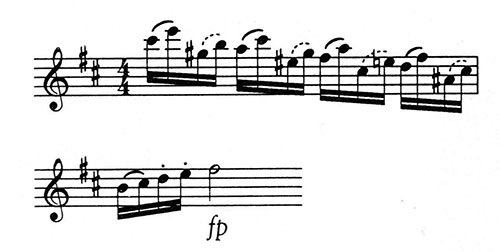
I was convinced this quasi-baroque interpretation was correct after hearing Emmanuel Pahud’s tasteful application of it in a beautiful recording with the Berlin Philharmonic (EMIC 56365), and I can well imagine a violinist jauntily adopting the same pattern. (See my "shifting-the beat" exercises for this passage in the April 2000 Flute Talk, page 23, and try the newly added two-note slurs).
Another deviation to consider is whenever rapid scales and arpeggios end with a single note on the following beat. Many composers write a slur across the beat while others detach the final note. Most of the 32nd-note scales in the last two pages of the Dutilleux Sonatine, for instance, are of the second variety but sound more effective and brilliant if slurred into the half-note trills. It is particularly suitable to slur into the high B# that ends the sweeping chromatic scale at [15] . Also consider slurring into the high F at [17] , and the F# on the first beat in the eighth bar of [10].
The sixteenth-note scales in the Scherzo movement of the Prokofiev Sonata (between [13] and [14] are slurred across the barline, but in the International edition (Rampal) the final F is detached. Because of the fast octave leap this sometimes results in a pause – an undesirable sixteenth rest – before the final note. In the first movement of the same sonata the five augmented triad arpeggios to altissimo D beginning in the six bar of [7] are detached from the D, but the high D might pop out more reliably if slurred – definitively a performer’s option. It is interesting to note that in David Oistrakh’s composer-sanctioned transcription of this sonata for violin and piano, the same arpeggio is transmuted into a double-stop sequence topped off by a non-piercing harmonic D that is the envy of most flutists.
Of course this slur-over-the-beat approach should not be applied if it offers no justifiable technical or musical advantage or if it violates the composer’s clear intent. I have heard performances and recordings of the Tchaikovsky Fourth Symphony Scherzo movement (meno mosso section) where the first oboe, followed by unison first and second flutes slur four 32nd-notes into the subsequent sixteenth note, tonguing only the second sixteenth rather than playing the printed slur-four-tongue-two articulation. This compromises the sparkling character of this famous passage.
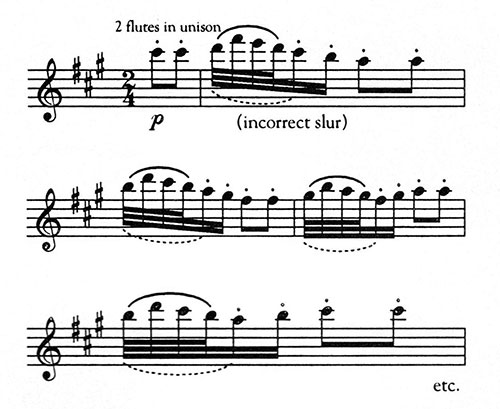
So with a tip of the hat (or bow) to the string players, we wind players could be more pliant in our attitude toward slur modifications; but remember – if you detach, don’t divide; and if you slur, don’t smear.
1 Gunther Schuller wrote a comprehensive 98-page performance analysis of the Brahms First in his excellent and provocative book, The Compleat Conductor (Oxford University Press, New York, 1997).

